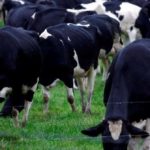
From cow burps to cow manure, it’s stirred up an ongoing debate: just how much methane do cattle emit, and can it be reduced? As global dairy companies set a new goal to trace and reduce emissions, U.S. dairy farmers are already taking steps to reduce emissions. Ongoing research is also helping find ways for dairy producers to cut their emissions even more.
The statistics are still contradictory. UC Davis researchers say cows and other ruminants account for only 4% of all greenhouse gases produced in the U.S. But the United Nations’ Food and Agriculture Organization claims livestock is responsible for about 30% of global anthropogenic methane emissions. The statistics may differ, but when it comes to agriculture, livestock accounts for the majority of the methane emissions, and the work to make livestock even more sustainable is already underway.
Dairy Methane Action Alliance Sets New Goal at COP28
According to Reuters, advocacy groups have said that tackling livestock methane should be a major priority at this year’s COP28 summit. In addition, at the summit in Dubai this week, six of the world’s largest dairy companies announced an alliance to cut methane emissions from dairy cows.
Reuters reports members of the Dairy Methane Action Alliance include Danone, Bel Group, General Mills, Lactalis USA, Kraft Heinz and Nestle. The Alliance says it will begin reporting their methane emissions by mid-2024 and will write methane action plans by the end of that year.
Feeding Red Seaweed to Dairy Cows
Researchers at University of Minnesota may have a head start, as they’ve already possibly found a way to cut those emissions by up to half, and the secret to change just may be in what the cows eat.
“One of the questions we’re trying to answer is, can we reduce methane emissions in dairy cows?” says Brad Heins, University of Minnesota animal science professor of dairy production systems.
The work is focused on feeding red seaweed to dairy cows in order to reduce methane emissions. Heins says the seaweed the researchers have found to be the most effective is red seaweed located on the coast of Hawaii.
“We’re feeding it to cows to reduce methane emissions, and we hope to see at least a 40% to 50% reduction in methane of dairy cows,” says Heins.
Heins says the early results are promising.
“There’s maybe some indication that it’s working,” he adds. “We’re not quite sure on the numbers yet, but the project is still ongoing.”
Heins says the amount of methane reduced varies by timing, as well as by different types of dairy cows.
“One thing that we’ve learned is that methane is quite variable in cows,” he says. “Cows fluctuate low in the morning and higher in the evening. It’s really based on feeding times. And we’re also finding that there’s maybe some differences in dairy cow breeds when it comes to methane emissions.”
Small Amount Goes a Long Way
Heins says what University of Minnesota researchers have already uncovered is that by feeding a very small amount of red seaweed, it can help reduce the methane emissions by up to half.
“It’s actually still normal feed with a little bit of that mixed in,” says Heins. “It’s less than an ounce per cow per day. So, a very small amount that we’re feeding to cows.”
Early Results are Promising
While the early results are promising, the team is currently working with dairy farmers from across Minnesota to ground-truth what they’re seeing.
“We’re working with farmers in many different aspects, with their grazing plans, how to feed their cows more efficiently. We’re working with them on environmentally sustainable goals to help improve dairy production in Minnesota,” says Heins.
What the University of Minnesota researchers have uncovered just may be a feasible solution that won’t require any major changes. So far, the work is uncovering promising potential with big results, proving that dairy farmers can be part of the sustainable solution.
“Our goal is to help reduce methane emissions in cows, improve the overall environmental sustainability of the dairy industry in Minnesota, and we think we’ll be able to achieve that,” says Heins.

























